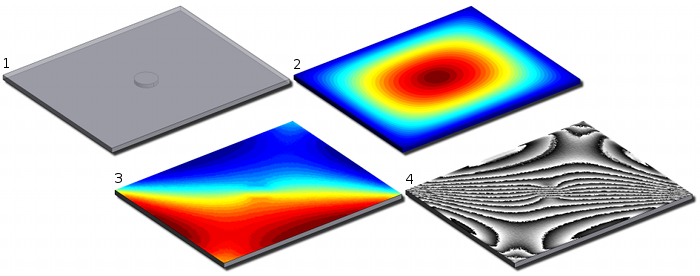This is an old revision of the document!
Shearography
Introduction
I am really no expert in shearography, so I will quote J.-F. Vandenrijt [1] for a proper definition: Shearography records the interference pattern between a speckle object wavefront and itself laterally displaced through an optical shearing device. Such interference patterns, so-called shearograms, are recorded at different instants between which the inspected object undergoes a certain stress (thermal, mechanical, pressure variation, vibration). The numerical difference between two shearograms gives rise to an interferogram which allows observing the derivative of the full-field displacement of the object under stress. A presence of defect induces a local signature in the interferogram.
In short, this technique is able to produce a fringe pattern which represents the derivative of the vertical displacement of the surface of the object. Defects in a structure can produce local perturbations of this pattern under appropriate loading, which is why shearography is used in non-destructive testing (NDT).
Marc Georges, from the Centre Spatial de Liège, proposed a master thesis project in collaboration with the Nonlinear Computational Mechanics group. The objective was to combine experimental tests at CSL with finite element simulations, to determine whether simulations can accurately predict the experimental fringe pattern generated by typical defects.
We were lucky enough to have two motivated students to work on this topic: Georges Crabus [2] focused on the experimental aspects in the CSL laboratory and Arthur Lismonde [3] made finite element simulations of the experiment.
Finite element simulations
References
[1] J.-F. Vandenrijt, N. Lièvre, M. Georges. Improvement of defect detection in shearography by using Principal Component Analysis. Proceedings of Conference on Interferometry XVII: Techniques and Analysis, 2014
[2] G. Crabus. Contrôle non-destructif par shearographie : développements expérimentaux de méthodes de stimulation thermique. Master thesis, Université de Liège, 2014
[3] A. Lismonde. Contrôle non-destructif par shearographie : simulations thermomécaniques de composites à renforts tissés. Master thesis, Université de Liège, 2014

